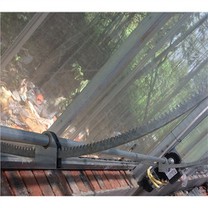1. How to add carbon dioxide
The average concentration of carbon dioxide in the atmosphere is 300-330 mg/L, with small fluctuations. In the production of vegetables in greenhouses in winter and spring, facilities are often closed for heat preservation, lack of internal and external gas exchange, and carbon dioxide concentration varies greatly, especially when the concentration drops at noon, close to or even below the compensation point, carbon dioxide is in a state of deficit. The following methods are for reference.
Apply granular organic biogas fertilizer. The granular organic biogas fertilizer is evenly applied between the rows of plants at a certain interval, and the application depth is 3 cm. Keep the soil in the acupoints with a certain amount of water and keep the relative humidity at about 80%, and use the soil microorganisms to ferment to produce carbon dioxide.
Chemical reaction method. Carbon dioxide is produced by chemical reactions between acids and carbonates. At present, dilute sulfuric acid and ammonium bicarbonate are mainly used to produce carbon dioxide gas in a simple gas fertilizer generator, which is released in a greenhouse through a pipeline. The use of 2.5 kg of ammonium bicarbonate per acre of standard greenhouse (about 1,300 cubic meters) can make the concentration of carbon dioxide reach about 900 mg/L. This method has low cost and easy control of carbon dioxide concentration. It is currently widely used in my country's greenhouse vegetable planting technology.
Combustion method. Through the carbon dioxide generator, the combustion of liquefied petroleum gas, propane gas, natural gas, white kerosene, etc. produces carbon dioxide.
2. How to avoid toxic gas hazards
Poisonous gases are often produced in the greenhouse, which affects the growth of vegetables. The following are some practical prevention measures.
Use safe and non-toxic agricultural film and mulching film to remove waste plastic products and residues in the shed in time. Avoid the poor quality of greenhouse film and mulching film, which will endanger the health of vegetables by emitting ethylene and chlorine at high temperature.
Fertilize reasonably. Organic fertilizers must be fermented to decompose, use high-quality fertilizers, and urea should be mixed with calcium superphosphate. The depth of base fertilizer is 20 cm, and the depth of topdressing chemical fertilizer is more than 12 cm. Water in time after application. Avoid excessive urea, ammonium nitrogen fertilizer and other quick-acting fertilizers that will produce ammonia and nitrous acid gas to poison vegetables under high temperature conditions.
Ventilation. In sunny and warm weather, ventilation and ventilation should be combined with temperature adjustment, and ventilation and ventilation should be properly conducted in rainy and snowy days.






